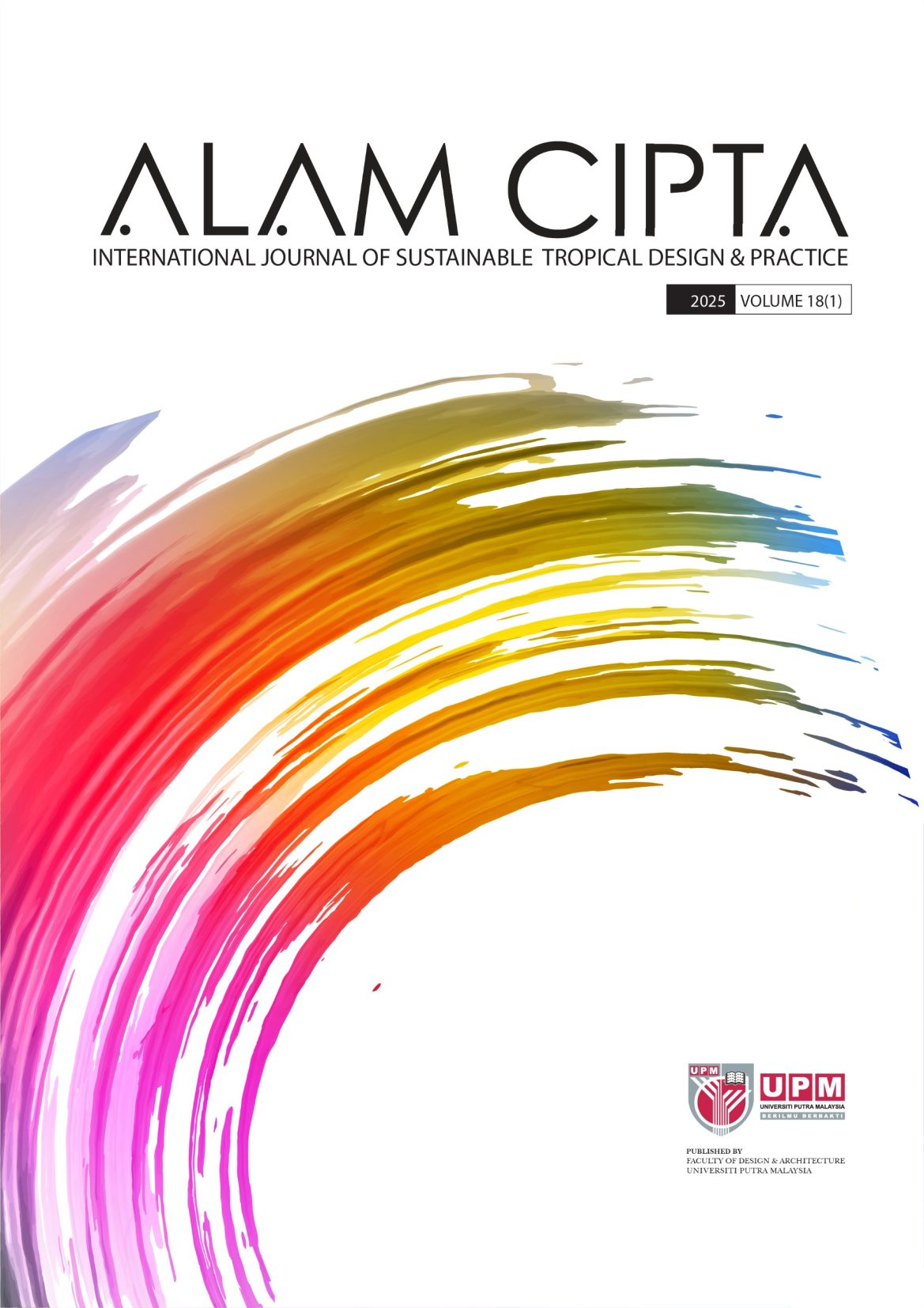
Aim
ALAM CIPTA aims to become one of the leading tropical-based journals devoted to ongoing design issues through integrative studies of social sciences and design discipline. It intends to position designers as the “creative integrator” of advanced technologies with the everyday needs of users and their communities. The journal promotes sustainable design, which has an international appeal. ALAM CIPTA would like to develop networks with local and international institutions and organisations by disseminating knowledge on sustainable design research and practice. The journal encourages discussions based on design and related theories supporting emerging sustainable design research and practice. ALAM CIPTA publishes research articles, short communications, systematic reviews or commentaries, and letters to the Editor or Errata.
Scope
Architecture | Art Criticism | Branding and Packaging | Construction | Cultural and Heritage | Digital Media Design | Environmental Behaviour | Fashion Design | Governance, Sustainability and Resilience | Green Technology | Heritage Conservation | History and Theory of Design | Hospitality and Tourism | Housing | Industrial Design | Interior Design | Land Planning and Management | Landscape Architecture | Multimedia and Graphic Design | Museology | Product Design | Responsive Environmental Design | Spatial Analysis | Teaching and Learning of Design Courses | Textile Design | Town Planning | Urban Environment | User Experience Design | Visual Art | Visual Quality Assessment |
Peer Review Process
ALAM CIPTA follows a double-blind peer review process. Peer review is fundamental to the scientific publication process and the dissemination of sound science. Peer reviewers are experts chosen by journal associate editors to provide a written assessment of the strengths and weaknesses of the manuscript, intending to improve the quality of the manuscript for the journal.
Two (2) or three (3) reviewers will independently evaluate the scientific quality of the submitted manuscripts. Authors are encouraged to indicate the names of 2 to 3 potential reviewers. These reviewers are subjected to the editor’s final choice and are not bound by these suggestions. Each manuscript will be assigned to an associate editor who decides to choose the reviewers. The comments from the reviewers will be sent back to the associate editors in a report which will be finally sent to the Editor-in-Chief to accept or reject the manuscript, invite the authors to revise and resubmit the manuscript, or seek additional review reports. If a revision is indicated, the editor provides guidelines to the authors for attending to the reviewers’ suggestions and perhaps additional advice about revising the manuscript.
The authors will then return a revised manuscript version to the Editor-in-Chief. The authors may also submit a rebuttal when the authors disagree with certain comments provided by the reviewers. Finally, the Editor-in-Chief sends the revised manuscript out for re-review. Typically, at least 1 of the original reviewers will be asked to examine the article. When the reviewers have completed their work, the Editor-in-Chief examines their comments and decides whether the manuscript is ready to be published, needs another round of revisions, or should be rejected.
Code of Ethics
ALAM CIPTA International Journal of Sustainable Tropical Design Research and Practice has adopted a Code of Ethics to ensure that its commitment to integrity is recognised and adhered to by contributors, editors and reviewers. For more details, please click here to download the Code of Ethics.
Indexing
ALAM CIPTA International Journal of Sustainable Tropical Design Research and Practice is indexed by SCOPUS (Elsevier), MyCite, EBSCO, ASEAN Citation Index (ACI) and Islamic World Science Citation Centre (ISC).
Publication frequency
The ALAM CIPTA journal will now be published quarterly, ensuring regular dissemination of research throughout the year.
Publishing Charge
Regular Issue : RM1000
Special Issue : RM1200
The publication fee for manuscripts accepted for publication will apply to each manuscript submitted on or after
January 1, 2025.
Manuscripts and other communication must be directed to the secretariat of the journal at the following address:
Assoc. Prof. Ts. Dr. Mohd Zairul Mohd Noor
Editor-in-Chief
ALAM CIPTA International Journal of Sustainable Tropical Design Research and Practice
Faculty of Design & Architecture
Universiti Putra Malaysia (UPM)
Serdang 43400
Selangor Darul Ehsan
Tel: +603-9769 4079
E-mail: alamciptaeditor@upm.edu.my
Current Issue
Volume 18 Issue 1 April 2025
Editor in Chief: Mohd Zairul
ISSN: 1823-7231
Frequency: 4 issues per year
Abstracting/Indexing:
SCOPUS, Malaysian Citation Index (MyCite), Google Scholar, Open Access Journals, EBSCO, Asian Citation Index, ISC
Content
Editorial
ENHANCING QUALITATIVE RESEARCH WITH THEMATIC ANALYSIS MATRIX (TAM): A SYSTEMATIC APPROACH TO THEMATIC ANALYSIS IN ARCHITECTURAL RESEARCH
Mohd Zairul
doi.org/10.47836/AC.18.1.ARTICLE1
ARTICLES
EVALUATION OF THE SHORT-TERM RENTAL HOUSING MARKET IN NIGERIA
Oyedeji, Joseph Oyewale, Oyesomo, Clement Oyewole, Ogunleye, Toyin Funmilayo, Adedamola, Akinola Wasiu, Oyedeji, Olajumoke Abiodun, and Ogunyinka, Margaret Abimbola
doi.org/10.47836/AC.18.1.ARTICLE2
RIPPLE EFFECT IN REGIONAL HOUSING MARKETS
Ekemode ,Benjamin Gbolahan and Safiu-Kolawole, Adebola Adedotun
doi.org/10.47836/AC.18.1.ARTICLE3
INTEGRATING DESIGN EXPERT INSIGHTS FOR ACHIEVING MARKET SUCCESS IN NEW PRODUCT DEVELOPMENT
Mohamad Saiful Sazwan Mohd Rashid, Hassan Alli, Ahmad Rizal Abdul Rahman and Khairul Manami Kamarudin
doi.org/10.47836/AC.18.1.ARTICLE4
NATURAL DAYLIGHTING SIMULATION OF BUILDING ATRIUM TOWARDS EFFECTIVE INDOOR ARTIFICIAL INTELLIGENCE-INTEGRATED URBAN FARMING IN MALAYSIA
Azlan Ariff Ali Ariff, Mohd Ezamil Mazlan, Mariam Felani Shaari, Liyana Mahfuzah Mohd For and Mohamed Tajulz’ Ariff Samsuddin
doi.org/10.47836/AC.18.1.ARTICLE5
ADAPTIVE REUSE IMPLEMENTATION IN PUBLIC FACILITIES: FROM RESIDENTIAL USE TO COMMUNITY HEALTH CENTERS
Nurtati Soewarno and Mustika Kusumaning Wardhani
doi.org/10.47836/AC.18.1.ARTICLE6
PRODUCT DESIGN INNOVATION FOR ENHANCING TABLE STABILITY ON VARIOUS OUTDOOR SURFACES
Mahendra Nur Hadiansyah, Desthyo Putra Pangestu, Ardian Jaya, Erlana Adli Wismoyo and Teuku Zulkarnain
doi.org/10.47836/AC.18.1.ARTICLE7
QUANTITATIVE RESEARCH ON THE SENSE OF PLACE: VISUALIZING LITERATURE THROUGH SYSTEMATIC REVIEWS AND BIBLIOMETRIC ANALYSIS
Yue Ma, Noor Fazamimah Mohd Ariffin, Faziawati Abdul Aziz, Xiao He, Yuanyuan Liu and Jing Zhao
doi.org/10.47836/AC.18.1.ARTICLE8
COMPATIBILITY OF LOCAL SPATIAL PLANNING BASED ON TRADITIONAL RULES IN KAMPUNG NAGA WITH THE FORMAL SPATIAL PLANNING IN INDONESIA
Saraswati and Irland Fardani
doi.org/10.47836/AC.18.1.ARTICLE9
ARTIFICIAL INTELLIGENCE (AI) AND ITS APPLICATION IN ARCHITECTURE DESIGN: A THEMATIC REVIEW
Deran Jin, Mohd Zairul and Sarah Abdulkareem Salih
doi.org/10.47836/AC.18.1.ARTICLE10







